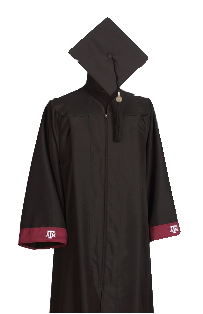Ceremonial Mace History
The University mace, a gift from the class of 1990, leads the academic procession at commencement and on other special ceremonial occasions. Historically, the use of a mace dates back to the middle ages and was carried before or placed near a magistrate or other dignitary as an ensign of authority.This mace is made of sterling silver, walnut and oak and depicts various University symbols. It was designed by Rodney Hill, Texas A&M architecture professor who also carved the staff. Silversmith Lane Coulter '78, of Santa Fe, prepared the silver head of the mace and Lars Stanley '74, of Austin, designed and manufactured the stand.

Academic Regalia History
Academic institutions throughout the world have created a wide variety of customs including distinctive dress, color and ceremony to indicate the accomplishments of scholars. English traditions originating at Oxford and Cambridge led to the development of American academic regalia. By the twentieth century, institutions of higher learning in the United States had adopted a well-defined code of academic costume, which now includes the identification of the different academic degrees by distinctive gowns, hoods and colors.
For instance, the baccalaureate gown is worn closed and is identified by long, pleated front panels and long, pointed sleeves. The master's gown has very long sleeves, closed at the bottom, and the arms of the wearer are placed through an opening in the front of the sleeves. Doctoral gowns may be worn open, and they are distinguished by velvet panels around the neck and down the front of the gown. Three horizontal black velvet bars, or the color representing the wearer's degree, also mark the doctorate. In America, the hood is the most colorful feature of academic regalia.
The bachelor's hood, when worn, is comparatively short; the master's, a bit longer; and the doctor's, at four feet, reaches far down the wearer's back. The outside of the hood is black and is bordered with a two, three or five inch band of velvet in the color representing the degree received, and the hood is lined with the colors of the granting institution. For instance, the Master of Arts hood from Texas A&M has a white border, for the discipline color of Arts, Letters and Humanities, with a maroon and white lining; and the Doctor of Philosophy hood has a border in the blue of Philosophy with a maroon and white lining. Among the other discipline colors are Agriculture-maize, Architecture-violet, Business Administration-olive green, Education-light blue, Engineering-orange, Medicine-green and Veterinary Medicine-gray. These colors represent the degree earned, not the academic major. The Ph.D. in Engineering, for example, would normally wear the dark blue of Philosophy on the hood and gown instead of the orange of Engineering. Official guests of the University and members of the Board of Regents wear the doctor's gown with the blue of Philosophy on the front and hood.
 Cap and gown for Baccalaureate Degree Candidates
Cap and gown for Baccalaureate Degree Candidates Cap and gown for Master's Degree Candidates
Cap and gown for Master's Degree Candidates Cap and gown for Doctoral Degree Candidates
Cap and gown for Doctoral Degree Candidates